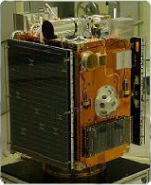닫기
| 인공위성연구센터 소개 | 인공위성관련 정보 | 연구개발 | 인력 양성 | 연구개발시설 | 산업기술지원 | 정보나눔 |
|---|---|---|---|---|---|---|
|
인사말 설립목적과 비전 연혁 조직도 찾아오시는 길 |
인공위성소개 - 인공위성 개요 - 주요 임무 - 내부구조 - 위성체조립 - 환경시험 - 발사 위성개발역사 |
우리별 위성 개발 - 우리별 1호 - 우리별 2호 - 우리별 3호 과학기술위성 개발 - 과학기술위성 1호 - 과학기술위성 2호 - 나로과학위성 - 과학기술위성 3호 차세대 소형위성 개발 초소형위성 군집시스템 개발 핵심우주기술 개발 - 다기능 구조체 - 고성능 탑재컴퓨터 개발 - 홀 추력기용 연료공급장치 - 리튬-이온 배터리 - 초소형 영상 분광기 - 고속데이터 시뮬레이터 과거수행 프로젝트 |
캔위성 체험·경연대회 뉴스페이스 리더 양성 - 사업 개요 - 사업 운영 - FAQ |
지상국 청정실 진동시험기 열진공 챔버 |
환경시험지원 - 진동시험 - 열진공/주기시험 |
공지사항 채용공고 사진자료실 |
| 전체메뉴닫기 | ||||||

Research and Development
STSAT-2
▶ HOME > Research and Development > STSAT Series > STSAT-2

∎ STSAT-2
STSAT-2 was Korea’s first 100kg low Earth orbit satellite to be launched in the first domestically developed launch vehicle (KSLV-1). Unfortunately, both STSAT-2A, launched on Aug. 25, 2009, and STSAT-2B, launched on Jun. 10, 2010, failed at the orbital injection stage.STSAT-2 utilized most of the experience and outcomes from the STSAT-1 project. The goals were to enhance performance and achieve further miniaturization.
STSAT-2 was a frame-type satellite structure and had been scheduled to test a range of core technologies including a composite material solar panel, Dual Head Star Tracker (DHST), CCD digital sun sensor, Pulsed Plasma Thruster (PPT), Compact on-board Satellite Computer, and X-band Transmitter.
- To operate a radiometer for earth and atmosphere monitoring
- To verify precise orbit and attitude determination technologies
- To develop and verify core satellite technologies
- To develop and operate world-class advanced observation devices
| Orbit | inclination 80°, altitude 300×1500km |
| Size | < 1m3 |
| Weight | < 100kg (Including adaptor) |
| Power Rating | 160WⓐEOL |
| Attitude Control Method | 3-axis stabilization, 0.15 deg pointing accuracy |
| Communication (Transfer Speed) |
S-band Uplink: 9.6kbps S-band Downlink: 38.4kbps X-band Downlink: 10Mpbs |
| Main Computer | Power PC 603e |
| Core Technologies |
Dual Head Star Tracker(DHST) Fine Digital Sun Sensor(FDSS) Pulsed Plasma Thruster(PPT) Electro-magnetic Torque(EMT) Compact On-board Computer X-band Transmitter |
| Payloads |
Dual-channel Radiometers for Earth and Atmosphere Monitoring(DREAM) Laser Reflector Array(LRA) |


